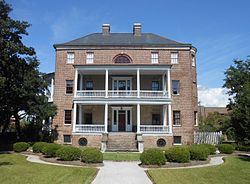Joseph Manigault House
Joseph Manigault House | |
 Joseph Manigault House | |
| Location | 350 Meeting St., Charleston, South Carolina |
|---|---|
| Coordinates | 32°47′19″N 79°56′7.7″W / 32.78861°N 79.935472°W |
| Built | 1803 |
| Architect | Gabriel Manigault |
| Architectural style | Early Republic |
| Part of | Charleston Historic District (ID66000964) |
| NRHP reference No. | 73001688 |
| Significant dates | |
| Added to NRHP | November 7, 1973[1] |
| Designated NHL | November 7, 1973[2] |
| Designated NHLDCP | October 9, 1960 |
The Joseph Manigault House is a historic house museum in Charleston, South Carolina that is owned and operated by the Charleston Museum. Built in 1803, it was designed by Gabriel Manigault to be the home of his brother, and is nationally significant as a well-executed and preserved example of Adam style architecture. It was declared a National Historic Landmark in 1973.[2][3]
Description and history
[edit]
The Manigault House is located near the center of the Charleston peninsula, at the corner of Meeting and John Streets. It is a three-story brick structure, set on a raised brick foundation. The main facade has a two-story porch across the center three bays, with elaborate doorways on both floors featuring slender pilasters and sidelight windows. A semicircular stairwell projects from one sidewall, and a bowed porch from the other, giving the house the rough shape of a parallelogram. The interior features delicately refined woodwork in its fireplace mantels, door and window moulding, and cornices, reflective of the style promoted by Robert Adam, which differentiated the scale of these elements in domestic and civic architecture.[3] The gatehouse standing near the property entrance is an architectural folly.[2]
The house was built in 1803 for Joseph Manigault to a design by his brother Gabriel. Gabriel Manigault had studied architecture in London before the American Revolutionary War, and was familiar with Robert Adam's design principles. This was the first major work of his to exhibit these principles, and was also one of the first houses in Charleston that was not obviously based on the standard "single house" and double house" models then commonly used. The house also includes a number of construction elements designed to minimize problems with pests.[3]
Manigault's executor sold the house in 1852 to George N. Reynolds, Jr., before it was passed onto John S. Riggs in 1864.[4] In 1920, the house was threatened with demolition to make way for a gas station. In response, a group of Charlestonians organized a preservation group which would become the Preservation Society of Charleston.
See also
[edit]- List of National Historic Landmarks in South Carolina
- National Register of Historic Places listings in Charleston, South Carolina
References
[edit]- ^ "National Register Information System". National Register of Historic Places. National Park Service. January 23, 2007.
- ^ a b c "Joseph Manigault House". National Historic Landmark summary listing. National Park Service. Archived from the original on June 6, 2011. Retrieved March 8, 2008.
- ^ a b c Tray Stephenson and Bernard Kearse (April 19, 1993). "National Register of Historic Places Inventory-Nomination: Joseph Manigault House" (pdf). National Park Service.
{{cite journal}}: Cite journal requires|journal=(help) and Accompanying one photo, exterior, from 1960 (32 KB) - ^ Smith, Alice R. Huger; Smith, D.E. Huger (2007). The Dwelling Houses of Charleston. Charleston: The History Press. pp. 71–75. ISBN 9781596292611.
External links
[edit]- Joseph Manigault House, at The Charleston Museum
- Joseph Manigault House, Charleston County (350 Meeting St., Charleston), at South Carolina Department of Archives and History


 French
French Deutsch
Deutsch


